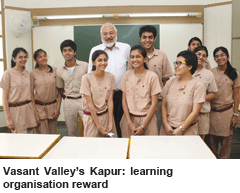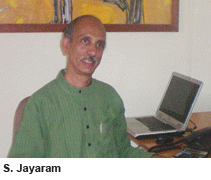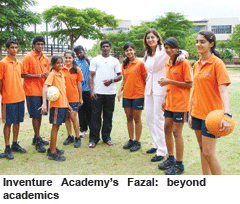India’s Top Day Schools 2012-13
The highlight of this year’s day schools rankings is the rise to the very top of the Vasant Valley School, Delhi followed by The Valley School, Bangalore. Both these schools reveal striking similarities of institutional values and philosophy
At the summit of the league table of India’s 342-day schools sufficiently well-known to be rated by at least 25 people included in the EducationWorld-C fore database of 3,070 sample respondents country-wide, the old order of the past four years has changed, yielding place to the new. The trio of The Shri Ram School, Delhi (TSRS), Cathedral and John Connon School, Mumbai (CJCS) and Mallya Aditi International School, Bangalore (MAIS) which has dominated the all-India day schools rankings for the past three years has been bested by Delhi’s Vasant Valley School and The Valley School, Bangalore, ranked first and second respectively in 2012.
 Impressive as is the steady rise in public esteem of Vasant Valley School, Delhi, promoted in 1990 by media tycoon Aroon Purie, promoter-chairman of the publicly listed Living Media Ltd, which was ranked No. 17 in 2008, No. 4 last year, and first this year, the ascent to No. 2 spot of The Valley School, Bangalore is more spectacular. This low-profile K-12 school promoted in 1978 to educate children in consonance with the precepts and practices of the late philosopher sage J.D. Krishnamurti (1895-1986), was ranked No. 86, 59, 61 and 10 in the years 2008-2011 before being catapulted to No. 2 this year.
Impressive as is the steady rise in public esteem of Vasant Valley School, Delhi, promoted in 1990 by media tycoon Aroon Purie, promoter-chairman of the publicly listed Living Media Ltd, which was ranked No. 17 in 2008, No. 4 last year, and first this year, the ascent to No. 2 spot of The Valley School, Bangalore is more spectacular. This low-profile K-12 school promoted in 1978 to educate children in consonance with the precepts and practices of the late philosopher sage J.D. Krishnamurti (1895-1986), was ranked No. 86, 59, 61 and 10 in the years 2008-2011 before being catapulted to No. 2 this year.
Although ousted from their apex positions, the TSRS, CJCS and MAIS trio continues to be numbered among the Top 5 day schools countrywide. But further down the list, there’s been considerable churn, with hitherto unfancied schools from down south breaking into the Top 10. Among them: the low-profile Centre For Learning, Bangalore which has moved up from No. 18 last year to No. 7 in 2012; The School, KFI (Krishnamurti Foundation Institute), Chennai (from No. 37 to 8); Vidyaranya High School, Hyderabad (No. 83 to 8) and the Sishya School (Adyar) Chennai(No. 21 to 9). Other primary-secondaries which have improved their ranking within the Top 10 this year are Smt. Sulochanadevi Singhania School (Thane), Mumbai from No. 8 in 2011 to 6 tied with Step by Step, Noida (No. 10 to 6) which has been steadily rising in public esteem.
“Being ranked as India’s most respected day school is certain to be a great morale booster to our parents, teachers and student communities, an assurance that we are on the right track. We have consciously set ourselves the goal of being a learning organisation in which students, teachers, and management are all learning continuously to actualise our own potential, and the full potential of our students. Therefore we are not afraid to adapt and implement new pedagogies such as collaborative and peer learning and invest heavily in teacher training and development. Awareness of this institutional culture within your informed sample respondents perhaps explains our top ranking this year,” says Arun Kapur, a history postgraduate of Delhi’s blue-chip St. Stephen’s College, who taught at the Doon School (1977-89) before being appointed the founder-principal of Vasant Valley in 1990.
Kapur takes special pride in the school’s success in mainstreaming challenged children, and integrating co-curricular and sports education in Vasant Valley’s curriculum. Significantly, the school is top-ranked under the parameters of competence of faculty, academic reputation, co-curricular education as well as provision of special needs education. Unsurprisingly Vasant Valley is also top-ranked under the parameter of leadership and quality of management, a tribute to Kapur’s vision and capabilities.
 S. Jayaram, a microbiology postgrad of Madras University and a former Syndicate Bank officer who switched tracks and signed up with the Chennai-based Krishnamurti Foundation, and served in three of the foundation’s five schools in India (and two abroad) before being appointed headmaster of The Valley School, Bangalore in 1999 and principal in 2008, is equally delighted with the great leap forward of the institution in the public perception. “Although we prefer to keep a low profile, I’m happy about public recognition of the holistic, values-based education that we provide. The high ranking we have received is great motivation to parents, students and teachers who constitute the close-knit Valley School family. I am especially pleased about our top ranking on the parameters of faculty competence, co-curricular and life-skills and conflict management education. We have a fantastic faculty, and the visual and performing arts are the beating heart of this institution. Moreover our high ranking under life-skills and conflict management education is very satisfying because there is heavy stress on inward growth of children to shape them into intelligent, sensitive and unselfish school-leavers equipped to cope with and contribute to society beyond school gates,” says Jayaram.
S. Jayaram, a microbiology postgrad of Madras University and a former Syndicate Bank officer who switched tracks and signed up with the Chennai-based Krishnamurti Foundation, and served in three of the foundation’s five schools in India (and two abroad) before being appointed headmaster of The Valley School, Bangalore in 1999 and principal in 2008, is equally delighted with the great leap forward of the institution in the public perception. “Although we prefer to keep a low profile, I’m happy about public recognition of the holistic, values-based education that we provide. The high ranking we have received is great motivation to parents, students and teachers who constitute the close-knit Valley School family. I am especially pleased about our top ranking on the parameters of faculty competence, co-curricular and life-skills and conflict management education. We have a fantastic faculty, and the visual and performing arts are the beating heart of this institution. Moreover our high ranking under life-skills and conflict management education is very satisfying because there is heavy stress on inward growth of children to shape them into intelligent, sensitive and unselfish school-leavers equipped to cope with and contribute to society beyond school gates,” says Jayaram.
 A closer examination of the reasons given by Kapur and Jayaram for their schools topping the EducationWorld India School Rankings 2012, reveals striking similarities of institutional values and philosophy. Both schools regard themselves as learning organisations with parent communities heavily involved with students’ education. Both are committed to adapting and implementing new pedagogies, and regard co-curricular and life-skills education as important as academics. Moreover, both top-ranked institutions have made elaborate provision for admitting and mainstreaming special needs children, indicative of strong values development orientation.
A closer examination of the reasons given by Kapur and Jayaram for their schools topping the EducationWorld India School Rankings 2012, reveals striking similarities of institutional values and philosophy. Both schools regard themselves as learning organisations with parent communities heavily involved with students’ education. Both are committed to adapting and implementing new pedagogies, and regard co-curricular and life-skills education as important as academics. Moreover, both top-ranked institutions have made elaborate provision for admitting and mainstreaming special needs children, indicative of strong values development orientation.
This is not to say that academic achievement — the sole criterion for admissions into the moribund government dominated collegiate system — is not important in these excellent schools. In the survey, the CBSE-affiliated Vasant Valley is also top-ranked under the parameter of academic reputation, with the CISCE-affiliated Valley School not far behind. Clearly, there is a shift in the attitude of the SECA parent community comprising 70 percent of the respondents database — which hitherto preferred drill-n-fill cram schools — in favour of institutions offering comprehensive, well-rounded primary-secondary education.
This mindset change is reflected in the second and succeeding deciles of the day schools league table as well. Schools reputed for according values, life-skills, performing and visual arts and sports high importance, have considerably improved their positions in this year’s rankings. Among them, Bharatiya Vidya Bhavan, Jubilee Hills, Hyderabad has vaulted from No. 43 in 2011 to 11 this year; Bombay International (29 to 17); Inventure Academy, Bangalore (21 to 17) and Blue Bells, Delhi (41 to 19). On the other hand, Bombay Scottish, Mother’s International, Delhi and Padma Seshadri Bala Bhavan and DAV Boys Senior Secondary (both in Chennai), reputed for excellent academics, have yielded ground this year.
That there’s been a seismic shift in parental attitudes, particularly within the trend-setting SECA social segment is confirmed by Nooraine Fazal, an alumna of Boston University and former globe-trotting Citibank manager who returned to India in 2003 to co-promote the Inventure Academy, Bangalore (IA, estb. 2005) of which she is the managing trustee. Although IA is of a mere seven-year vintage, it has been steadily moving up the EW all-India day schools league table from 49 in 2008 to 17 currently, outpacing old favourites such as Bishop Cotton Boys and Girls (estb. 1865) and St. Joseph’s (estb. 1858) which are ranked 29, 35 and 56 respectively this year.
 “There’s no doubt that while they don’t discount the value of sound academic education, today parents are looking at school education from a broader perspective and according greater importance to co-curricular and extra-curricular activities — including environmental and life-skills education. In IA, 60 percent of students’ time in primary school is allocated for academics and 40 percent for what we term ‘beyond academics’ education. And though in high school beyond academics activities reduce to 25 percent, we are committed to dispensing creative, holistic education to our students. This is one explanation why the number of students in IA has grown from 29 in 2005 to 780 currently,” says Fazal.
“There’s no doubt that while they don’t discount the value of sound academic education, today parents are looking at school education from a broader perspective and according greater importance to co-curricular and extra-curricular activities — including environmental and life-skills education. In IA, 60 percent of students’ time in primary school is allocated for academics and 40 percent for what we term ‘beyond academics’ education. And though in high school beyond academics activities reduce to 25 percent, we are committed to dispensing creative, holistic education to our students. This is one explanation why the number of students in IA has grown from 29 in 2005 to 780 currently,” says Fazal.
Further down the league table of India’s most respected days schools as well, new age schools which accord considerable even if not equal importance to co-curricular, life-skills and sports education, have sharply improved their national ranking. Among them: Bal Bharati School, Pitampura, Delhi from 59 in 2011 to 21 this year; Strawberry Fields, Chandigarh (40 to 24); Tagore International, Delhi (48 to 24);Bharatiya Vidya Bhavan, Chennai (113 to 26) ; Oakridge International, Hyderabad (52 to 29); and the newly-promoted Ebenezer International, Bangalore (73 to 45), all of whom — together with several hitherto unranked primary-secondaries (Bal Bharati, Ganga Ram Hospital, Delhi; St. Mary’s, Safdarjung, Delhi) are ranked among the country’s Top 50 day schools.
Given that the total number of schools countrywide aggregates 1.30 million including 80,000 private schools (200,000 according to the Union HRD ministry which lists primary, upper primary, high and higher secondary schools separately), to be listed among the Top 100 or even 158 day schools is no small achievement. Among new and previously unranked schools in the Top 100 areNath Valley, Aurangabad which has debuted at No. 57; B.D. Somani International (65), and Hiranandani Foundation, Powai (66) both in Mumbai; Shishukunj, Indore (69) and theTrivandrum International School, Thiruvananthapuram (92); La Martiniere Girls College, Lucknow (49).
Moreover within the Top 100 DRS International, Hyderabad (79 to 50); PSBB Millennium (89 to 58); Symbiosis International, Pune (119 to 60); NASR School, Hyderabad (82 to 61); Ryan International, Kandivali, Mumbai (121 to 65);Jubilee Hills Public, Hyderabad (90 to 67) and The Heritage School, Kolkata (135 to 70) have risen considerably in the esteem of the informed public.
However it is pertinent to note that while national league tables are useful for the purposes of prestige and bench-marking for school managements, for parent communities pan-India rankings are of peripheral interest as parents are more interested in the pecking order of schools in their local geographies and at best in their states. Therefore this year the regional league tables of day (and boarding) schools have been abolished and replaced by state and city league tables.
Moreover, given that by international standards India’s states are actually countries in their own right — the population of Uttar Pradesh is 200 million — league tables featuring top-ranked schools in states make much more sense than broader regional tables cutting across several state boundaries. State and city league tables for day schools are set out separately.
For all-India Day schools league table and Parameters of Excellence India’s Top 10 Day schools go to:
/userfiles/India’s Best Day Schools league table-pgs(3).pdf
/userfiles/Parameters of Excellence India’s Top 10 Day Schools-pgs.pdf















Add comment